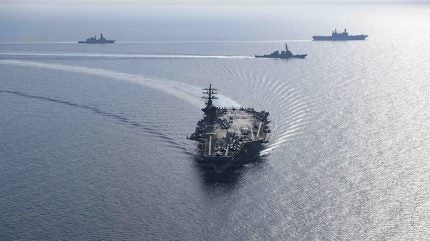
As the US Navy shuffles its aircraft carrier pack around to accommodate the various tasks and demands placed upon the fleet, a potential two-week carrier-borne combat air capability gap has emerged in the US Central Command (CENTCOM) area of responsibility (AOR).
This has been created by the transit of the USS Dwight D Eisenhower carrier strike group (CSG) out of CENTCOM’s AOR on 22 June 2024, into the US-European Command in the Mediterranean.
It is understood the USS Dwight D Eisenhower CSG will be positioned in the eastern Mediterranean for a period of time, before heading back to the US at the conclusion of a more than seven-month-long deployment.
A US Department of Defense (DoD) spokesperson on 24 June declined to state whether its deployment was related to potential flash points between Israel and Hezbollah in southern Lebanon, nor outline the likely duration of its mission in the eastern Mediterranean.
However, the CSG of the USS Theodore Roosevelt will take some time to arrive in the CENTCOM AOR from the Asia-Pacific region, where the aircraft carrier is due to undertake joint exercises with South Korean forces. The USS Theodore Roosevelt arrived in Busan on 22 June.
Travelling by the most expeditious route from Busan, South Korea, to the US Navy’s Naval Support Activity at Mina Salman in Bahrain, home of the Fifth Fleet, is a journey of some 13,000km. At a speed of 30 knots, which would be at the top end of any naval transit, this would take around ten days.
Taking precautions such as avoiding transiting through Taiwan Strait would add more time to the journey.
The DoD spokesperson confirmed on 24 June that the USS Theodore Roosevelt would begin its transit “to the CENTCOM AOR” after completing its exercise in the Indo-Pacific “next week”.
Responding to media queries, the DoD spokesperson said the US Navy maintained destroyers in the EUCOM and CENTCOM AORs to provide maritime security, as well other “aircraft and ISR” capabilities.
US Navy gaps inevitable, but where are Europe’s carriers?
The US Navy maintains ten Nimitz– and one Ford-class nuclear-powered aircraft carriers in its fleet, which are the largest (Ford) and second largest (Nimitz) warships in the world at more than 100,000 tonnes displacement, each class able to accommodate up to 100 aircraft in their embarked air wing.
While the US operates other naval assets in CENTCOM’s AOR as part of the Fifth Fleet, currently tasked with escort and maritime security operations in the Red Sea to protect shipping from attacks by Iranian-backed Houthis in Yemen, the absence of an aircraft carrier in the Middle East region for what could be a number of weeks, is notable.
The absence of a US Navy carrier in the Middle East for a period comes after European allies were unable to fill a previous gap, despite France, the UK, and Italy all operating aircraft carriers.
Italy’s aircraft carrier ITS Cavour was operating briefly in the Red Sea region in early June, but has since left to Middle East, arriving in Singapore on 24 June for exercises in the Asia-Pacific region.
The French Navy is also currently operating its aircraft carrier Charles de Gaulle in the eastern Mediterranean, as part of wider Nato collective defence efforts.
The UK Royal Navy’s own Queen Elizabeth-class aircraft carriers are enduring a difficult spell, suffering with propulsion issues that have impact recent planned operations.
During the concept development of the class, which replaced the smaller Invincible carriers, UK naval officials espoused a vision to “slot into” the US Navy’s own force movements, driving the design of the Queen Elizabeth class to an eventual displacement of 70,000 tonnes.
A UK carrier not scheduled to transit through the Suez Canal and into Red Sea and wider Indian Ocean until 2025, with the deployment of HMS Prince of Wales to the Asia-Pacific region.





